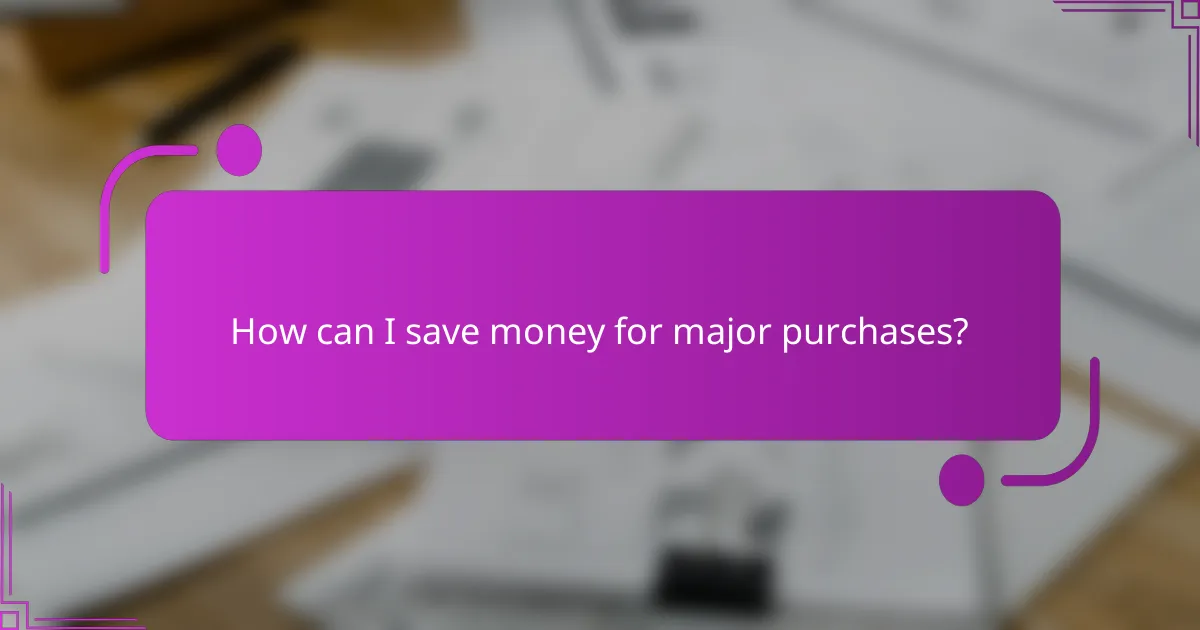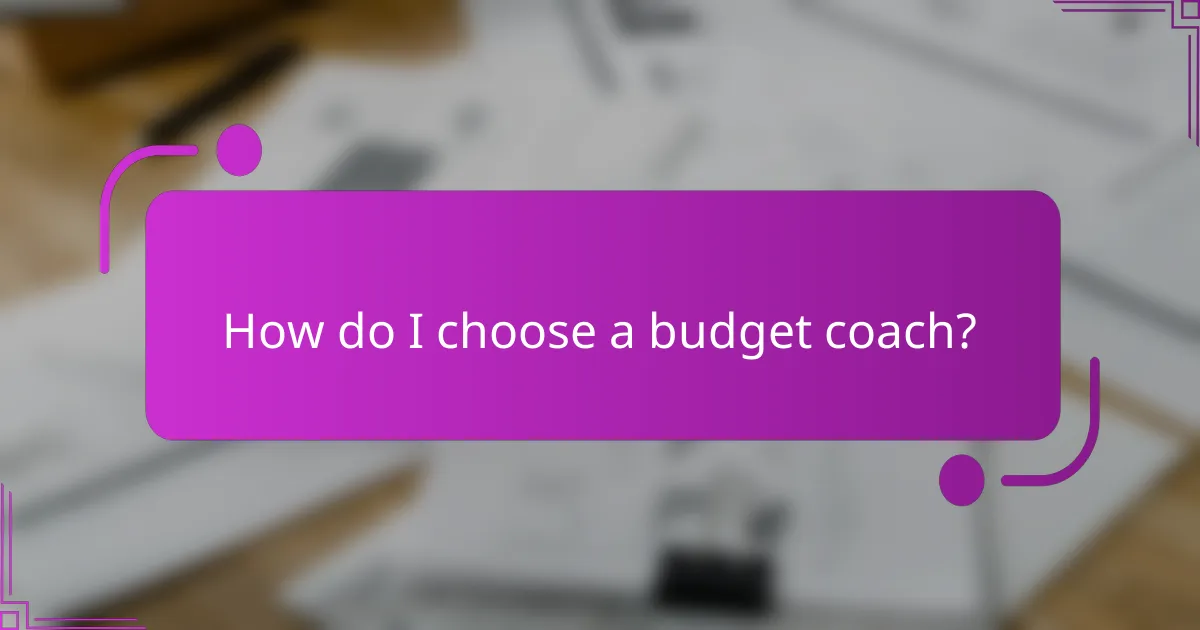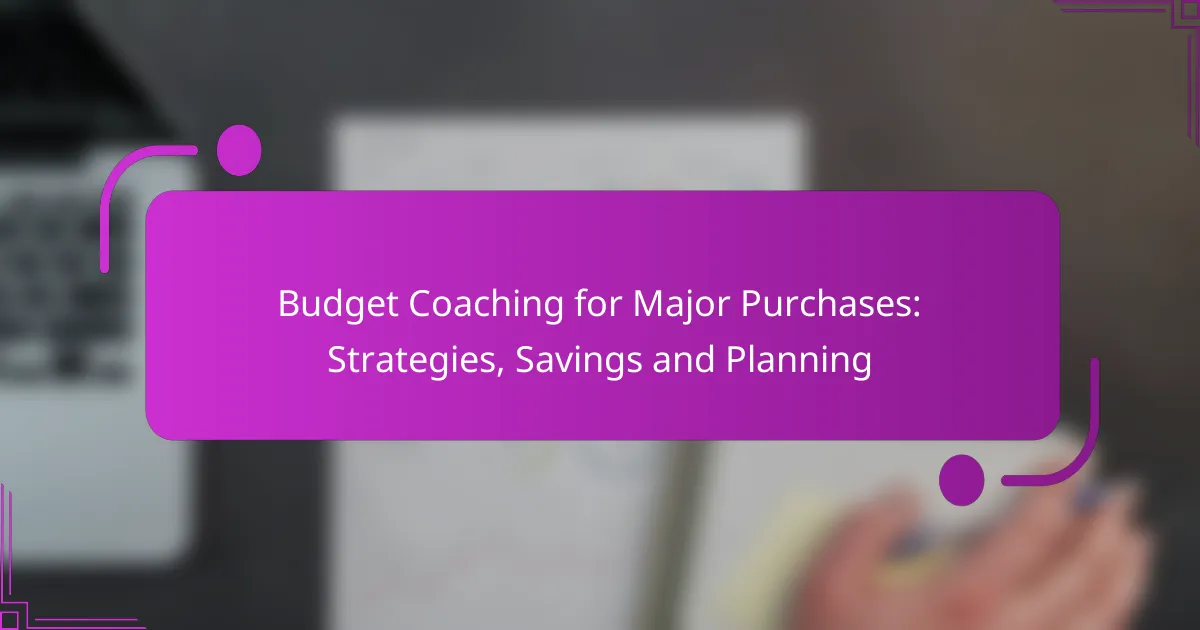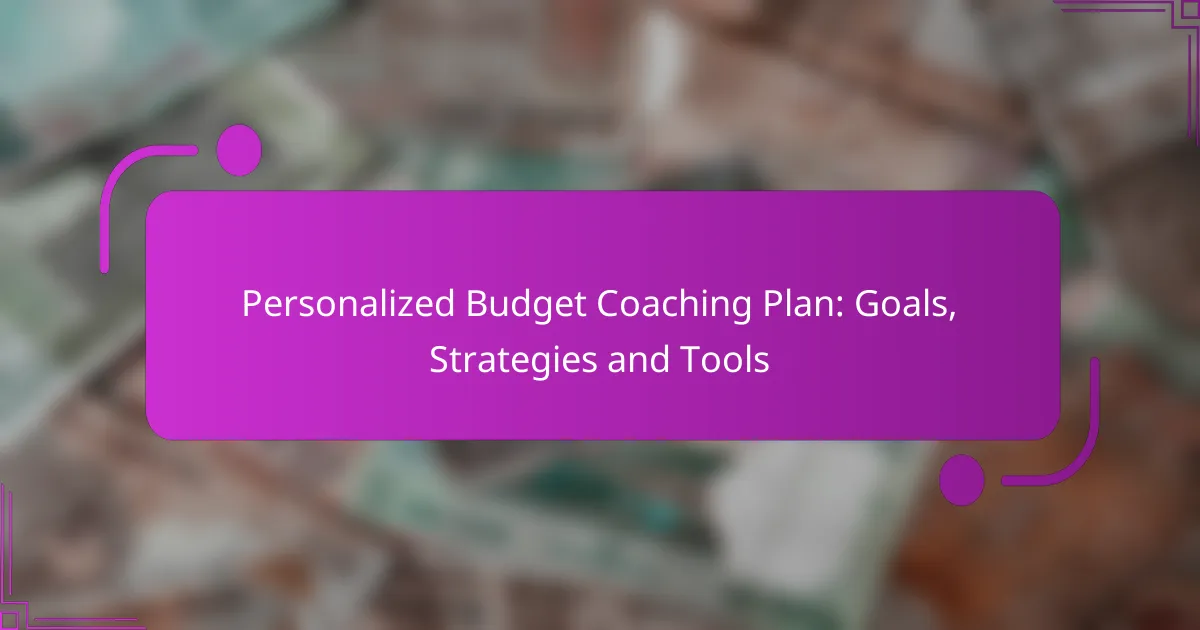Budget coaching for major purchases is essential for achieving financial stability while making significant investments. By setting clear goals and creating a detailed budget, individuals can strategically save and plan for their desired purchases. Utilizing effective tools and coaching services further enhances the ability to manage finances and make informed decisions, ensuring a smoother purchasing process.

What are the best budget coaching strategies for major purchases?
Effective budget coaching strategies for major purchases focus on setting clear goals, creating a detailed budget, and utilizing coaching services. These approaches help individuals manage their finances better, ensuring they can make significant purchases without compromising their financial stability.
Setting clear financial goals
Establishing clear financial goals is essential for successful budgeting. Start by identifying what major purchases you want to make, such as a home, car, or vacation, and set specific timelines for achieving these goals. This clarity helps prioritize spending and motivates saving efforts.
Consider using the SMART criteria—Specific, Measurable, Achievable, Relevant, and Time-bound—to refine your goals. For example, instead of saying “I want to buy a car,” specify “I want to save $15,000 for a car in the next two years.” This makes tracking progress easier and more actionable.
Creating a detailed budget plan
A detailed budget plan outlines your income and expenses, providing a roadmap for reaching your financial goals. Begin by listing all sources of income and fixed expenses, such as rent or utilities, followed by variable expenses like groceries and entertainment.
Allocate a portion of your income specifically for savings towards your major purchase. A common recommendation is to save at least 20% of your income for such goals. Regularly review and adjust your budget to reflect changes in your financial situation or priorities.
Utilizing coaching services
Coaching services can provide personalized guidance and accountability in your budgeting journey. A financial coach can help you identify spending habits, set realistic goals, and create a tailored budget plan that aligns with your lifestyle and aspirations.
Look for certified financial coaches or organizations that offer workshops and resources. Many coaches provide initial consultations for free, allowing you to assess their approach before committing to a longer-term engagement.
Tracking expenses effectively
Tracking your expenses is crucial for staying on budget and achieving your financial goals. Use apps or spreadsheets to record daily spending, categorize expenses, and compare them against your budget plan. This practice helps identify areas where you can cut back.
Consider setting a weekly or monthly review session to analyze your spending patterns. This not only keeps you accountable but also allows you to adjust your budget as needed to stay on track for your major purchases.
Prioritizing needs over wants
When budgeting for major purchases, it’s vital to distinguish between needs and wants. Needs are essential expenses that support your basic living requirements, while wants are discretionary and can often be postponed. Focus on fulfilling your needs first to maintain financial stability.
Implement a “30-day rule” for non-essential purchases: if you want to buy something that isn’t a necessity, wait 30 days. This cooling-off period can help you evaluate whether the purchase is truly worthwhile and aligns with your financial goals.

How can I save money for major purchases?
Saving money for major purchases involves setting clear goals, creating a budget, and consistently setting aside funds. By employing strategic methods, you can accumulate the necessary amount over time without straining your finances.
Establishing a dedicated savings account
Opening a dedicated savings account specifically for major purchases helps you separate these funds from your everyday spending. Look for accounts with high interest rates to maximize your savings. Aim to automate transfers to this account each month to ensure consistent contributions.
Consider setting a target amount based on your purchase goal. For example, if you plan to buy a car costing around $20,000, determine how much you need to save monthly to reach that goal within your desired timeframe.
Implementing the 50/30/20 rule
The 50/30/20 rule is a budgeting method that allocates 50% of your income to needs, 30% to wants, and 20% to savings. By following this guideline, you can effectively manage your expenses while still prioritizing savings for major purchases.
To apply this rule, calculate your after-tax income and divide it accordingly. For instance, if your monthly income is $3,000, allocate $600 for savings. This approach helps you build a substantial fund over time while maintaining a balanced lifestyle.
Using cashback and rewards programs
Cashback and rewards programs can significantly enhance your savings for major purchases. By utilizing credit cards or apps that offer cashback on everyday purchases, you can earn money back on items you would buy anyway.
For example, if you spend $500 monthly on groceries and earn 2% cashback, you would accumulate $12 each month. Over a year, that adds up to $144, which can then be directed towards your major purchase fund. Just ensure you pay off your balance in full each month to avoid interest charges.

What tools can assist with budget coaching?
Several tools can significantly enhance budget coaching by helping individuals manage their finances effectively. These tools offer features for tracking expenses, planning budgets, and monitoring investments, making it easier to make informed financial decisions.
Mint for budgeting
Mint is a popular budgeting tool that allows users to connect their bank accounts, credit cards, and bills to track spending in real-time. It categorizes expenses automatically, providing insights into spending habits and helping users identify areas for potential savings.
To get started with Mint, simply create an account and link your financial accounts. Set up budget goals based on your income and expenses, and Mint will send alerts when you approach or exceed your budget limits. This proactive approach helps maintain financial discipline.
You Need a Budget (YNAB) for planning
You Need a Budget (YNAB) is designed for proactive financial planning, emphasizing the importance of assigning every dollar a job. This method encourages users to prioritize their spending and savings, making it easier to allocate funds for major purchases.
YNAB operates on a subscription model, offering a 34-day free trial. Users can create specific categories for expenses, track their progress, and adjust budgets as needed. This flexibility is crucial for adapting to changing financial situations and achieving long-term goals.
Personal Capital for tracking investments
Personal Capital is an investment tracking tool that provides a comprehensive view of your financial health. It allows users to monitor their investments, track net worth, and plan for retirement, making it an excellent resource for those focused on long-term financial goals.
By linking investment accounts, Personal Capital offers insights into asset allocation and investment performance. Users can set retirement goals and receive personalized advice based on their financial situation. This holistic approach helps ensure that budgeting aligns with broader investment strategies.

What are the common pitfalls in budget coaching?
Common pitfalls in budget coaching often lead to overspending and financial stress. Recognizing these mistakes can help individuals create more effective budgets and achieve their financial goals.
Ignoring small expenses
Small expenses can accumulate quickly and significantly impact your budget. Regularly overlooking these costs, such as daily coffee purchases or subscription services, can lead to a budget that appears balanced but is actually off track.
To avoid this pitfall, track all spending, no matter how minor. Consider using budgeting apps or spreadsheets to categorize and sum these expenses, ensuring they are accounted for in your overall financial plan.
Overestimating income
Overestimating income can create unrealistic expectations in budgeting. Many individuals may project their earnings based on potential raises or bonuses rather than their current, stable income.
To mitigate this risk, base your budget on conservative income estimates. Use your net income from the previous few months as a guideline, and avoid including uncertain income sources to maintain a realistic financial outlook.
Neglecting emergency funds
Neglecting to build an emergency fund can leave you vulnerable to unexpected expenses, such as medical bills or car repairs. Without a financial cushion, you may resort to credit cards or loans, leading to debt accumulation.
Establish an emergency fund that covers at least three to six months’ worth of living expenses. Set aside a small percentage of your income each month until you reach your target, ensuring you are prepared for unforeseen circumstances.

How do I choose a budget coach?
Choosing a budget coach involves evaluating their qualifications, experience, and approach to ensure they align with your financial goals. A good budget coach can help you plan for major purchases by providing tailored strategies and accountability.
Checking credentials and experience
Start by verifying the coach’s qualifications, such as certifications in financial planning or coaching. Look for experience specifically in budgeting and major purchases, as this indicates they understand the nuances of financial management.
Consider how long they have been in the field and whether they have worked with clients who have similar financial situations to yours. A coach with several years of experience is likely to have encountered various challenges and developed effective strategies.
Reading client testimonials
Client testimonials can provide insights into a coach’s effectiveness and style. Look for reviews that highlight specific outcomes, such as successful savings for a home or car purchase, which indicate the coach’s ability to deliver results.
Pay attention to the overall tone of the testimonials. Positive feedback about the coach’s communication skills and support can be a good indicator of a productive coaching relationship.
Understanding coaching methodologies
Different budget coaches may employ various methodologies, such as zero-based budgeting or the envelope system. Familiarize yourself with these approaches to determine which aligns best with your financial habits and goals.
Ask potential coaches about their process for setting goals and tracking progress. A structured methodology can help ensure that you stay on track with your budget and make informed decisions about major purchases.

What are the benefits of budget coaching for major purchases?
Budget coaching for major purchases helps individuals make informed financial decisions, ultimately leading to better savings and spending habits. By working with a coach, consumers can clarify their goals, understand their financial situation, and develop actionable plans to achieve their purchasing objectives.
Improved financial literacy
One of the primary benefits of budget coaching is enhanced financial literacy. Clients learn to navigate complex financial concepts, such as interest rates, savings strategies, and budgeting techniques, which are crucial for making significant purchases. This knowledge empowers them to make informed decisions rather than relying on impulse or external advice.
Coaches often provide tailored resources and tools that help clients understand their financial landscape. For instance, they might introduce budgeting apps or spreadsheets that track income and expenses, allowing clients to visualize their financial health. This hands-on approach fosters a deeper understanding of personal finance.
To maximize the benefits of improved financial literacy, clients should actively engage in discussions with their coaches and ask questions. Regularly reviewing financial goals and progress can reinforce learning and help identify areas for further development. Additionally, clients should seek out educational materials, such as books or online courses, to supplement their coaching experience.



